Brian Schiff’s Blog
Injury Prevention, Sports Rehab & Performance Training Expert
So, I have been swamped with work and marathon training, hence the recent delay in a new blog post. Well, yesterday during a short 3 mile run (I am in taper mode with a 10/17 event) I experienced an acute left hamstring strain.
Hamstring strains are common and can produce incredible pain and limit function. Most hamstring strains occur as the swing leg is coming forward and the knee is nearing full extension. Essentially, it is a stretch type injury as the hamstring works to decelerate the momentum of the lower leg.
Injuries may be casued by inadequate warm-up, a sudden increase i training intensity/volume, fatigue, stiffness, weakness or muscle imbalances. A prior injury may also increase your risk for re-injury.
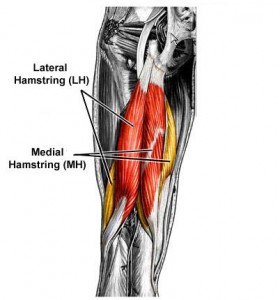
I have been running for years and am 5 months into my marathon training, so why now? I honestly think it may be related to my speed yesterday. My body naturally leans toward a 7:25 pace, but when I looked down at my Garmin yesterday at the point of pain, it said 6:54. Yikes! I was 1.25 miles into the short run.
I decided to keep running and slow my pace back to 7:30. While I was able to complete the run, my lower hamstring was very tight and sore after the run. Obviously, I have been icing regularly the last 24 hours. No running today either. I anticipate a quick recovery since the strain is mild and I am very fit. But, what is the best way to prevent re-injury?
I have a quick article summary from the Journal of Sports & Orthopedic Physical therapy Journal for you to read that underscores how important functional movement rehab is in comparison to just static stretching and strengthening.
Click here to read the summary of the journal article
Now, with respect to running, agility may not be necessary. Running is fairly linear (straight line) so what may be more important to gage capacity to return to running may be some of the following:
- Absence of pain with active knee straightening
- Absence of pain with walking
- No pain with single leg hopping
- Minimal to no muscle belly tenderness
In the end, you will need to let pain guide you. Some will return faster than others, but inside of 21 days (the end of the subacute healing phase) you must be aware of the fragility of the tissue as it heals. I am confident this will not derail my marathon, but the lesson learned is to watch your starting pace as it may lead to some muscle strain.
I was asked to comment on a thought provoking blog post on MyPhyscialTherapySpace.com. There is ongoing discussion with respect to the exact role a therapist should play in the continuum of care for patients. I enjoyed reading the posts on there and I have posted my reply on my blog for you to see (not to mention the fact the blog site would not let me post my entire repsonse in a single comment). To read the original post click the link below:
Now my comments…….
I would say as a cash based practitioner currently living in the sports performance and post-rehab fitness realm (I own a fitness training facility), I would say that many of my therapy colleagues do not truly understand how to push and/or fully rehabilitate people to a high enough level that meets the pre-injury functional capacity.
I often see referrals that have already failed traditional rehab or are getting inadequate therapy. Why? In many cases, PT’s are following basic protocols, not supervising exercise progression closely enough, moving too slowly or in some cases (ACL rehab) moving too fast. I also find clinicians are often hesitant or perhaps unwilling to change treatment progressions within the sessions, reps or sets even if the client’s response to the stimulus indicates such a change.
The longer I work with clients, the more hip issues I see. Generally speaking, I find the major issues to be related to decreased mobility, poor stability and muscle imbalances. These may occur in isolation or combination.
It is a no-brainer that most people have tight hip flexors and external rotators given all the sitting that takes place in our computer age. This inherently creates weakness and tightness. I feel that a natural propensity to be positioned in hip external rotation may actually reduce the firing of these muscles which in turn allows for more valgus moments at the knee and reduces lower limb stability.
Typically, female athletes fail to adequately fire the gluteus maximus (hip extension and external rotation) and prefer to dominate movement with the quads. So, how do we begin to change this?
Well, first we must focus on better hip mobility. I believe we must work to gain better hip extension by stretching the hip flexor group. I also believe we need to do this dynamically and not just passively. A dynamic approach also allows us to improve knee stability on the opposite side as we work on hip mobility. It will also allow us to resist internal rotation of the femur and the valgus moment at the forward knee.
Look at the images below:
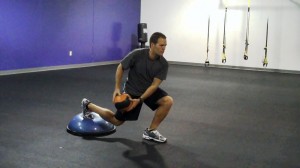
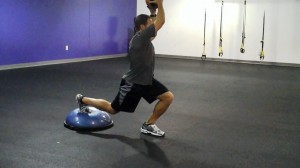
I am demonstrating a BOSU split squat diagonal chop. This is the first of a series of BOSU exercises I am doing for PFP Magazine. The upward chop forces hip extension on the right side and the downward motion reinforces firing of the left glutes to reduce internal rotation and valgus. What a perfect combo right?
To read more about this exercise, click here.
Now, you should start on the floor with just the arms and progress from there. This is a great prehab exercise or warm-up activity, but it cna also be used for strengthening too. I hope you find it as beneficial in your routine as I do.
So, for Labor Day 2010, I decided to take my family to Kings Island. I have always been a fan of thrill rides and it has been well over a decade since I had been to Kings Island. It was also before I have experienced more than one bout of sciatica.
My nieces live nearby and they agrred to watch my sons for a brief time while my wife and I headed off to ride some of the bigger rides. I insisted we ride the Beast – a coaster classic by any standards. It is the world’s longest wood coaster and lots of fun.
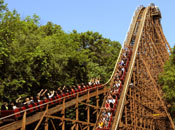
What I failed to remember was just how much jarring and abuse the good ol’ Beast could inflict on one’s body in those tiny little cars. After 4 minutes of fun, it all came back to me. For those who don’t know, I have been training for a marathon and admittedly after most 19 plus mile runs (I did one on Sunday) my back is stiff for a day or two.
Perhaps riding the Beast (and the Racers too at my wife’s insistence) the day after a long run was not such a wise move. 🙂 I woke up this morning with what I term “old man back.” Now while that may sound funny, to anyone who has experienced it, you know how unpleasant it is.
I crawled out of bed and managed to teach a boot camp class at 5:30 AM without incident. Beyond the stiffness, my day has been marked by difficulty bending forward and lots of ice. I am not complaining as much as I am telling you that as we get older (unfortunately I mean older than age 30) our shock absorption qualities in the spine begin to decline.
You see, our discs between the vertebrae act as a cushion and help prevent injury. But, as we age, they naturally begin to degenerate in our thirties (degenerative disc disease – bummer). This ultimately means we are more vulnerable to harmful forces and stress on the spine. Ever wonder why those signs warn you not to ride if you have neck or back pain?
It is likely the sudden torque, twists, turns and bumps that may leave you feeling rough then next day. Am I saying not to ride? NO!! I love coasters. I will be back at it again in the near future. What I am saying is know your own personal situation and if you have some past back issues like me, be prepared to endure “old man back” for a few days as you hit the theme parks.
I will be over it in a day or so. As a matter fo fact I ran 4 miles today with no pain. Some keys to spinal fitness are:
- Practice good body mechanics with bending, lifting, sitting, etc.
- Don’t sit too much without standing up. Our bodies need balance, and too much sitting (flexion) is bad for the discs in the back. Be sure to stand up no less than once per hour as your back craves to be in extension an equal amount of time. Standing back bends (sets of 5-10) is a great way to improve spinal fitness if you have a desk job.
- Stretch and strengthen the abdominals, but avoid full sit-ups.
- Strengthen the low back muscles and hips.
- Avoid flexion and rotation moments.
In the end, if you have a flare-up, then use ice and let pain guide your movements. One last tip: stick to the steel coasters for a smoother ride!
Over the years, I have worked with hundreds of athletes (male and female). One consistent finding among many I see is weakness in the hips and core. Knee injuries are often the result of poor frontal and transverse plane stability, which is often related to weakness in the glutes (max and medius).
In order to resist valgus/rotational loads effectively, athletes must address this weakness with training. I am always looking for ways to get the most out of exercise provided it makes sense to me. So, I began using the exercise I am sharing with you today – BOSU planks with hip abduction/extension. I use both to work on the gluteus maximus and medius muscles. This exercise targets hip and core weakenss at the same time.
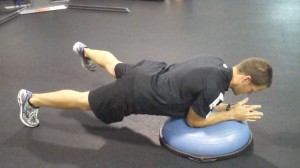
Hip Abduction
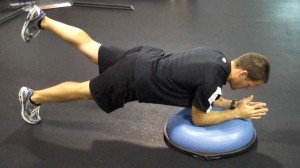
Hip Extension
Click here read how to execute the exercise and apply it to your routines.

